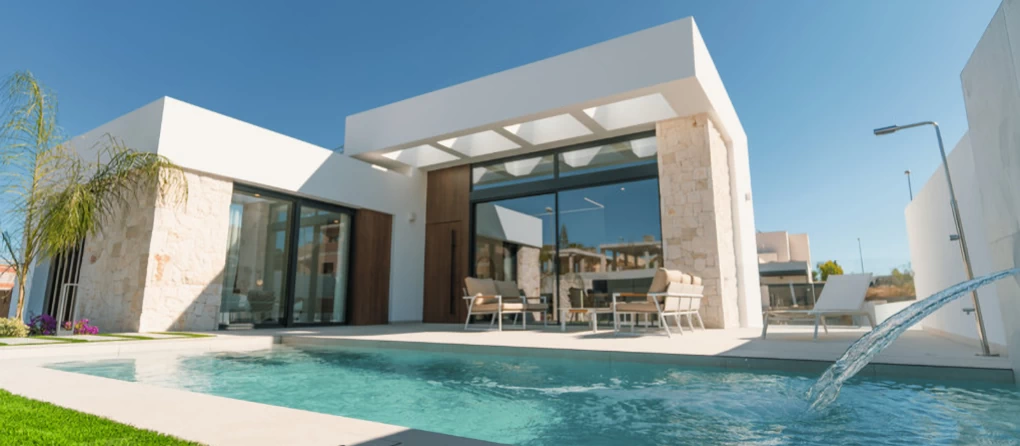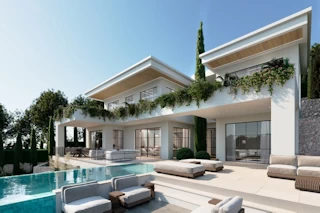Design ideas for a home in Spain have changed substantially in recent years.
Modern Spanish Home Designs: A Shift in Style. See the gallery here.
The Spanish home design landscape has undergone a significant transformation in recent years. It has largely moved away from traditional, ornate styles (which many still love), towards a more contemporary and minimalist approach. This is seen in almost all new developments project these days.
This article covers the following main points.
- How have the designs changed – what are the main differences?
- Some new design ideas and considerations.
- What makes a home in Spain a healthy environment, regardless of size or budget?
1. Comparing Traditional to Modern.
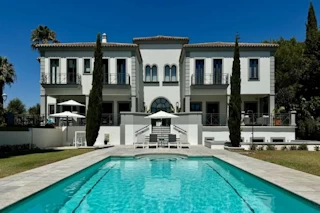 1.1. Traditional. Characterized by whitewashed walls, terracotta roof tiles, intricate wrought iron balconies, and a strong emphasis on natural materials like stone and wood. Attractive, but interior spaces were often dark and cluttered with heavy furniture. This has become very unfashionable.
1.1. Traditional. Characterized by whitewashed walls, terracotta roof tiles, intricate wrought iron balconies, and a strong emphasis on natural materials like stone and wood. Attractive, but interior spaces were often dark and cluttered with heavy furniture. This has become very unfashionable.
1.2. Modern. Modern Spanish homes now tend to embrace clean lines, open floor plans, large windows for natural light, and a focus on sustainability. The use of concrete, stainless steel, and glass is prominent- Traditional materials like wood are used with a more minimalist touch.
2.1. Colour Palette. While white remains popular, modern designs incorporate bolder colours like terracotta, olive green, and blue to add vibrancy.
2.2. Material Focus. Modern designs favor sleek, contemporary materials over ornate traditional elements. This means less wrought iron and more steel, less intricate tiles and more polished concrete.
2.3. Indoor-Outdoor Living. Modern homes emphasize seamless transitions between indoor and outdoor spaces, with expansive terraces and patios becoming integral parts of the living experience.
2.4. Self sufficiency and sustainability. Modern Spanish homes are designed with clarity towards energy efficiency. Solar panels, rainwater harvesting systems, and green building materials.
3. Some new design Ideas to incorporate into your project.
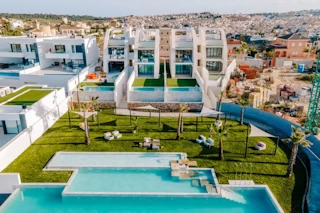 3.1. Bioclimatic Architecture. Harnessing the power of the sun for heating and cooling. Incorporating passive ventilation systems. Strategical placement of large windows to optimize natural light.
3.1. Bioclimatic Architecture. Harnessing the power of the sun for heating and cooling. Incorporating passive ventilation systems. Strategical placement of large windows to optimize natural light.
3.2. Minimalist Interiors. Simple furniture, neutral color palettes, and an emphasis on natural textures. This creates a calming and spacious environment.
3.3. Open-Plan Living. Connecting the living, dining, and kitchen areas to create a feeling of openness and flow, blurring the lines between spaces.
3.4. Outdoor Oasis. Designing expansive terraces, patios, and courtyards with lush vegetation, outdoor kitchens, and fire pits to create a tranquil retreat. Lightened and enhanced by modern (relatively inexpensive) solar lamps.
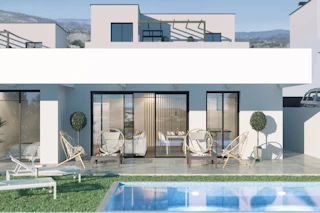 3.5. If feasible and available, installing a water well from natural sources. This is possible in more areas than has been previously considered, mostly due the increased capabilities of modern drilling equipment.
3.5. If feasible and available, installing a water well from natural sources. This is possible in more areas than has been previously considered, mostly due the increased capabilities of modern drilling equipment.
Although it must be said, it is almost impossible in many parts of Spain, particularly the south east. In such cases, rain water harvesting may prove essential, and in some areas it is abundant.
4. Healthy Home Design Ideas.
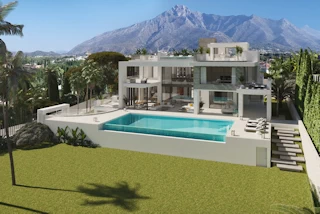 4.1. Natural Ventilation. Employing strategically placed windows and cross-ventilation systems to encourage airflow and minimize the need for air conditioning.
4.1. Natural Ventilation. Employing strategically placed windows and cross-ventilation systems to encourage airflow and minimize the need for air conditioning.
4.2. High-Quality Indoor Air. Using low-VOC paints, sustainable building materials, and indoor plants to improve air quality.
4.3. Plenty of Natural Light. Maximizing daylight through large windows and skylights to promote a sense of well-being and reduce reliance on artificial lighting.
4.4. Mindful Material Selection. Choosing non-toxic materials for furniture, flooring, and finishes to minimize harmful chemicals and allergens.
 4.5. Green Spaces. Incorporating green roofs, vertical gardens, or a small vegetable garden to connect with nature and enhance air quality.
4.5. Green Spaces. Incorporating green roofs, vertical gardens, or a small vegetable garden to connect with nature and enhance air quality.
4.6. Water Conservation. Implementing rainwater harvesting systems, low-flow fixtures, and drought-tolerant landscaping to reduce water consumption.
4.7. Energy Efficiency. Using solar panels, insulation, and efficient appliances to reduce energy usage and minimize environmental impact.
5. Conclusion.
By combining modern design elements with a focus on sustainability and healthy living, a home in Spain, regardless of size or budget ,can become a beautiful and functional space. This altogether promotes well-being and minimizes the environmental footprint.
Gallery of stunning design ideas is here to inspire you.
Author: Anthony. Sources: Personal experience of self-sustainable living. Gemini (formerly Bard). Spain – various Government.
WMO: World Meteorological Organization. A global website presenting OFFICIAL weather observations, weather forecasts and climatological information. For selected cities supplied by National Meteorological & Hydrological Services (NMHSs) worldwide. These make official weather observations in their respective countries.
ECMWF: European Centre for Medium-Range Weather Forecasts. A research institute and a 24/7 operational service, producing global numerical weather predictions and other data for our Members, Co-operating States, and the broader community. They operate a world-class supercomputer facility for weather forecasting and hold one of the largest meteorological data archives.
Wikis: The Costa del Sol | Costa Blanca (external: new windows)

